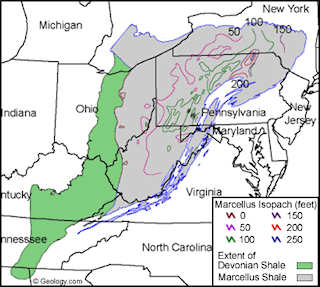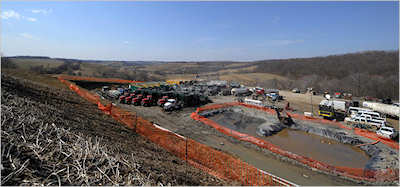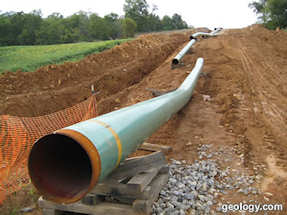 I attended a seminar presented by the National Resource Defense Council (NRDC) on Monday at a solar-energy run building called "Solar One" on the lower East River coast of Manhattan.
I attended a seminar presented by the National Resource Defense Council (NRDC) on Monday at a solar-energy run building called "Solar One" on the lower East River coast of Manhattan.
The topic was "Drill, Baby, Drill: Marcellus Shale's Natural Gas and NYC's Drinking Water". Hopefully that is the last time we hear "Drill, Baby, Drill" in a public discussion, but I suppose that is as likely as Sarah Palin disappearing into the frozen reaches of northern Alaska! In any case, there was a warm, friendly environment at Solar One, a totally solar-powered and heated building in Manhattan's downtown east side, near the East River, and a lively and well-informed audience attending this presentation.
The event description at Meetup.com was: "Join Kate Sinding, Senior Attorney at the Natural Resources Defense Council, and Joe Levine of Damascus Citizens for Sustainability, for a survey of the key environmental and economic concerns surrounding Marcellus Shale". It sounded like a rather "dry" topic, and I almost did not attend. However, I took a humble and curious approach, and so attended. Seeing the revealing regulatory and educational issues raised, as well as the environmental implications of the large Marcellus Shale development goals, I am glad I did attend.
The serious questions raised by the energy industry's Marcellus Shale development plans turns out to be of greater interest than the usual policy language titles would indicate, and the issue has wide implications for people in multiple Northeastern states (NY, PA, OH, WV, and MD) including my home state, New York. The same discussion also applies to other areas of the United States and the world where gas wells are being drilled in other gas shale regions (in the United States: most similar are Texas and Oklahoma, with a variety of shale formations in several other Western states).
 I learned about the large gap between the "small, clean well pads" promised by the gas companies, compared to the reality of severe water pollution, air quality problems, truck traffic, diesel equipment noise, and venting and leaks of methane during operations. There is a good deal of information with an environmental and liveability focus at the Catskill Mountainkeeper Web site.
I learned about the large gap between the "small, clean well pads" promised by the gas companies, compared to the reality of severe water pollution, air quality problems, truck traffic, diesel equipment noise, and venting and leaks of methane during operations. There is a good deal of information with an environmental and liveability focus at the Catskill Mountainkeeper Web site.
There are interesting policy issues. The federal government has been prevented from controlling the drilling due to various regulations passed and the weakening of the EPA. Some states are very happy to cooperate with construction of ten of thousands of gas wells per state as a source of tax revenue and lower cost energy. However, the analysis of hidden costs is almost never done.
Local municipities and counties have only limited control, since these projects are implemented as contracts between a gas company and an individual land owner. The county can control taxation and road construction and usage patterns, but of course any "unreasonable" restriction to prevent business is frequently viewed as excessive by courts and will not stand.
 Additionally, exemptions on use of the toxic liquids use to fractionate the shale (Federal Energy Act of 2005 and other Federal actions before 2005; see write-up) to release the trapped gas, are provided by state governments before the legislators fully understand the impact of such development. Approximately 250 chemicals are added to the water to enhance gas release; many of those chemicals have been identified as toxic by laboratories that have analyzed the by-products of the "fracking" of the shale with this fresh water plus chemical mix.
Additionally, exemptions on use of the toxic liquids use to fractionate the shale (Federal Energy Act of 2005 and other Federal actions before 2005; see write-up) to release the trapped gas, are provided by state governments before the legislators fully understand the impact of such development. Approximately 250 chemicals are added to the water to enhance gas release; many of those chemicals have been identified as toxic by laboratories that have analyzed the by-products of the "fracking" of the shale with this fresh water plus chemical mix.
An Environmental Impact Statement (EIS) is generally not needed by the gas well projects because each well is prepared as a stand-alone project, thus avoiding the project size that triggers the need for an EIS.
Compounding the difficulty of controlling these individual contracts that sneak under the radar of environmental protection laws is the collusion by government agencies that are generally trusted by farmers and land owners, again motivated by tax revenues and probably without understanding the full impact of such developments. Thus, in Pennsylvania, PennState Cooperative Extension, the agriculural school (funded by Chevron), and the PA Department of Environmental Protection were actively advising land owners that it was a good idea to welcome the gas wells onto their land, and in many cases said there were no chemicals to be used, in other words, that only pure clean water and clean, safe natural gas would be involved in the gas well operations. This was not true, however. And due to adverse health effects they experienced, a number of the landowners with gas wells have permanently left their land.
*** Check the video with this article: "Pond and Farm Ruined" ***
It is too late for West Virginia, the most cooperative state. Pennsylvania and Ohio have been partially developed but their regulatory mechnisms did kick in and have slowed down the gas companies (including Chesapeake Energy, Stone Energy, Seneca Energy, Range Resources, Devon Energy, Encana and others). Now they are trying to develop New York State, but the citizenry in New York is better warned due to the damage visible in the other Marcellus Shale states that have been developed.
Hopefully, from my viewpoint, New York and organizations such as NRDC will be able to put significant restrictions on the gas drilling, especially around the watershed for the New York City drinking supply, still one of the best municipal systems in the country (although the levels of chlorine needed to keep the water free of microbes has steadily increased). Beyond that, there is educating of land owners of the true impact of the land use for well drilling.
With our current economic times, it will indeed be a difficult and prolonged fight to protect our environment while figuring out what to do with the tremendous gas reserves in the Northeast.
Suggested Web sites:
www.OGAP.org
www.NRDC.org
www.EndocrineDisruption.org
www.DamascusCitizens.org